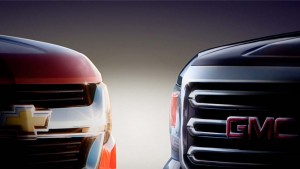As it prepares to roll out the new mid-sized trucks, the Chevrolet Colorado and GMC Canyon, at the Los Angeles Auto Show next, General Motors is pursuing what it describes as a three-truck strategy.
While GM has put more emphasis on its passenger cars in the past few years, GM still depends on its truck line for the bulk of its profits, notes Joe Phillippi, an independent analyst, who keeps a watch of GM.
“They make some money on the cars,” he said, adding that the margins on the trucks are much greater.
GM North America President Mark Reuss said the introduction of Colorado and Canyon early next year will give GM something none of its competitors possess: an entry in each of the three main segments inside the U.S. pick up truck market. GM will have a mid-sized truck, a full-sized or standard-sized pick up and a new heavy-duty pick up on the market by next spring, Reuss recently said.
None of GM’s competitors in the light truck segment, Ford, Ram, Toyota or Nissan, have the same broad coverage. Ford and Ram, GM’s principal competitors, have both standard and heavy-duty pickups trucks but no mid-sized pickup. Toyota and Nissan, on the other hand, have standard-sized pickup trucks and mid-sized trucks, but no heavy-duty trucks, which are widely used in ranching, farming and construction.
The three-truck strategy will give GM a chance to challenge all comers and attack markets where it has the potential to gain share such as among gardeners in Southern California and South Florida where the Toyota Tacoma has always been a popular choice, Reuss said.
Jack Hollis, Toyota vice president, says Toyota is aiming to protect its turf in Southern California especially where its dealer network is exceptionally strong.
Ram also expects to continue to grow in both the standard and heavy-duty segments, according to Reid Bigland, head of the Ram brand and the Chrysler Group. The introduction of the diesel-powered version of the standard Ram, which was just named the “Truck of Texas,” will help Ram pick up share, he said.
Reuss refused to comment on speculation that GM was prepared to offer a diesel-powered version of either and the standard-sized Silverado or GMC Sierra or the new Colorado and Canyon. “We don’t have anything to tell you,” he said.
(Ram diesel captures top honors in Texas. For more, Click Here.)
Meanwhile, executives at Ford Truck, GM’s principal rival for the U.S. truck, are watching the moves at Chevrolet and GMC.
Doug Scott, director of marketing for Ford’s F-150, said Ford has studied the mid-sized truck market extensively and doesn’t see the need for a mid-sized truck in the U.S., which is why it decided not to replace the Ford Ranger. Ford’s decision was influenced, in part, by GM’s efforts to sell the original Colorado that ended in failure during the recession.
(Click Here to read about GM’s heavy-duty trucks.)
“All you wind up doing is cannibalizing your full-size truck,” said Scott, who said Ford concluded it would not gain more business by building mid-sized trucks, which have evolved in the decade to become slightly smaller version of full-size pickup trucks.
GM, however, does gain some practical benefits from the introduction of the Colorado and Canyon. The new trucks are slated to be built on the same assembly line in Wentzville, Mo. where GM also builds cargo vans. By combining production of the mid-sized truck and vans, GM keeps the plant operating full tilt, Phillippi said.


No manufacturer sells a small truck either. All of the former small trucks grew into mid-size trucks. Thanks GM, but I’ll wait for a small truck.
It’s simple: If enough consumers desire a third sized pick-up it will sell well enough. If not, it will disappear as many before have done.